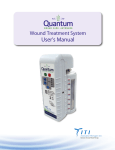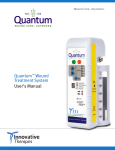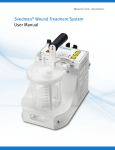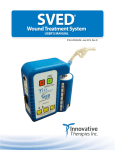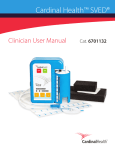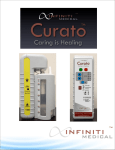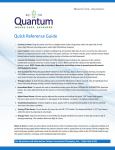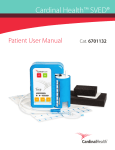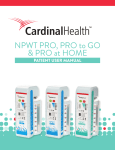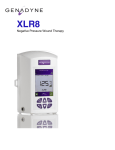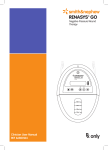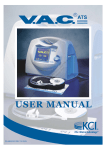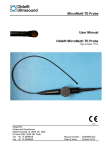Download SVED® Wound Treatment System User Manual
Transcript
SVED® Wound Treatment System User Manual CAUTION: This SVED® Wound Treatment System User’s Manual is not a guarantee or warranty. It is intended only as an operational guide. For additional information and questions, please contact Innovative Therapies, Inc.’s (ITI) Customer Service department at 1-866-ITI-NPWT (484-6798). • In order for the SVED Wound Treatment System to provide safe, reliable, and proper performance, the following conditions must be met. Failure to comply with these conditions will void all pertinent warranties. • All assembly, operation, adjustment, modification, maintenance, and/or repair must be carried out only by qualified personnel authorized by ITI. • The electrical installation of the room in which the device will be used must comply with applicable wiring standards and electrical codes. • The product must be used in accordance with this manual and all associated labeling and the Instructions for Use. Notice to Users: CAUTION: Federal law restricts this device to sale by or on the order of a physician. As with any prescription medical device, failure to follow product instructions or changing settings and performing therapy applications without the express direction and/or supervision of a trained clinical caregiver may lead to improper product performance and the potential for serious or fatal injury. Table of Contents 1. Introduction .................................................................................. 1 Indications ................................................................................... 1 Contraindications .......................................................................... 1 Precautions .................................................................................. 1 Additional Precautions .................................................................. 1 Safety Tips..................................................................................... 2 Features ....................................................................................... 4 2. Care & Cleaning............................................................................. 5 Introduction.................................................................................. 5 Protective Equipment..................................................................... 5 Disposal........................................................................................ 5 Daily Care and Cleaning................................................................. 6 Weekly Care and Cleaning.............................................................. 6 3. Patient Care................................................................................... 7 Applying the Dressing.................................................................... 7 Canister Installation ...................................................................... 9 Canister Removal ........................................................................ 10 Dressing Removal ....................................................................... 10 Disposal of Dressings and Canister ............................................... 11 4. Operating Instructions ................................................................ 12 Power ON/OFF............................................................................. 12 Power-Up Procedure......................................................................13 Therapy Setting Adjustment ......................................................... 14 Battery Operation ........................................................................15 Alarm Operation .......................................................................... 16 Therapy Selection Lock/Unlock......................................................17 5. Specifications ............................................................................. 18 Symbols ..................................................................................... 19 6. Replacement Parts ...................................................................... 20 7. Questions I Information ................................................................21 1. Introduction Indications The SVED® Wound Treatment System is indicated for patients who would benefit from vacuum assisted drainage with delivery of topical wound treatment solutions and suspensions over the wound bed. Types of wounds for which the SVED Wound Treatment System has been indicated include chronic, acute, traumatic, subacute, and dehisced wounds, diabetic ulcers, pressure ulcers, flaps and grafts. Contraindications The SVED Wound Treatment System is contraindicated for patients with malignancy in the wound, untreated osteomyelitis, non-enteric and unexplored fistulas, or necrotic tissue with eschar present. Do not place the Svamp® Dressing over exposed blood vessels or organs. The Svamp Dressings are also contraindicated for hydrogen peroxide and solutions which are alcohol based or contain alcohol. It is not recommended to deliver fluids to the thoracic cavity. Precautions Precautions should be taken for patients with active bleeding, difficult wound hemostasis, or who are on anticoagulants. When placing the Svamp Dressing in close proximity to blood vessels or organs, take care to ensure that they are adequately protected with overlying fascia, tissue or other protective barriers. Exposed tendon, nerves or blood vessels should be protected by moving available muscle or fascia over them or by a layer of synthetic material. Greater care should be taken with respect to weakened, irradiated or sutured blood vessels or organs. Bone fragments or sharp edges could puncture a dressing barrier, vessel or organ. Wounds with enteric fistula require special precautions in order to optimize therapy. Additional Precautions • Defibrillation: Remove the Svamp Dressing if defibrillation is required in the area of dressing placement. Failure to remove the dressing may inhibit electrical current transmission and/or patient resuscitation. • Magnetic Resonance Imaging (MRI): The SVED Wound Treatment Unit is not MRI-compatible. Do not take into the MRI area. • Large Canisters: Use of Large Canisters (>500ml) may increase serious risks associated with excessive fluid loss. Monitor patient status continually. DO NOT USE for infants or other patients with low fluid volume, nor for patients at high risk of major hemorrhage. • The SVED Wound Treatment System is intended for use with saline solutions in a physiologic pH range that can optionally include topical wound treatment solutions. • Various topical agents, such as hydrogen peroxide, are not intended for extended tissue contact. If in doubt about the appropriateness of using a solution with the SVED® Wound Treatment System, contact the solution’s manufacturer. • Do not apply solutions in conflict with the manufacturer’s instructions for use. • During irrigation therapy, the Svamp Dressing is a closed system and is NOT vented to atmosphere. SVED System User’s Manual 1 • Do not use where temperature of fluid could cause an adverse reaction, such as a change in patient’s core body temperature. • During irrigation therapy, the irrigation bag should be checked periodically to ensure proper fluid delivery. In addition, when a canister fills with fluid, it should be replaced immediately as irrigation fluid and wound exudate will not be removed from the dressing once the canister is full. SAFETY TIPS KEEP THERAPY ON The SVED Wound Treatment System should be operated at least 22 hours out of every 24 hour period. Remove the Svamp Dressing if therapy is terminated or is off for more than 2 hours in a 24 hour period. DRESSING CHANGES Clean the wound per physician order prior to dressing application. Routine dressing changes should occur every 48 to 72 hours. Dressing changes for infected wounds should be accomplished more frequently then 48-72 hours. Always replace with sterile disposables from unopened packages. Follow established institution protocols regarding clean versus sterile technique. MONITORING THE WOUND Inspect the dressing frequently to ensure that the foam is collapsed and that therapy is being delivered in a consistent manner. Monitor periwound tissue and exudate for signs of infection or other complications.* Extra care and attention should be given if there are any signs of possible infection or related complications. Infection can be serious. With or without the SVED Wound Treatment System, infection can lead to many adverse complications including pain, discomfort, fever, gangrene, toxic shock, septic shock, and various other complications. With signs of more serious complications of infection, discontinue use of the SVED Wound Treatment System until the serious infection is diagnosed and properly treated. DISCOMFORT/ADHERENCE If patient complains of discomfort during dressing change, consider pre-medication, use of a non-adherent prior to foam placement or irrigation of a topical anesthetic agent such as 1% Lidocaine prior to dressing removal. UNSTABLE STRUCTURES Over unstable body structures such as unstable chest wall or non-intact fascia, use the lowest pressure setting on the SVED Wound Treatment Unit. SPINAL CORD INJURY In the event a patient experiences autonomic hyperreflexia (sudden elevation in blood pressure or heart rate in response to stimulation of the sympathetic nervoussystem) discontinue use of the SVED® Wound Treatment System to help minimize sensory stimulation. SVED System User’s Manual 2 BODY CAVITY WOUNDS Underlying structures must be covered by natural tissues or synthetic materials that form a complete barrier between the underlying structures and the Svamp Dressing. Svamp DRESSING USE The Svamp Dressings distributed by Innovative Therapies, Inc. are to be used exclusively with the SVED Wound Treatment System. NOTE: All dressing components of the SVED Wound Treatment System are packaged sterile. The decision to use clean versus sterile/aseptic technique is dependent upon wound pathophysiology and physician/clinician preference. All components of the SVED Wound Treatment System disposable set are latex free. Be sure to comply with all other CONTRAINDICATIONS and PRECAUTIONS for the SVED Wound Treatment System. *Signs of possible infection may include fever, tenderness, redness, swelling, itching, rash, increased warmth in the wound area, purulent discharge or a strong odor. Nausea, vomiting, diarrhea, headache, dizziness, fainting, sore throat with swelling of the mucous membrane, disorientation, high fever (>102°F, 38.8°C), refractory hypotension, orthostatic hypotension, or erythroderma (a sunburn-like rash) may be added signs of more serious complications of infection. WARNING: Do not pack the Svamp Dressings into any areas of the wound. Forcing dressings in a compressed manner into any wound is contrary to approved protocols. SVED System User’s Manual 3 Features Easy-to-use “One Touch” Operation: Therapy can be activated simply with the push of a single button. Therapy level can be quickly changed by pressing one of three buttons (-70 mmHg, -120 mmHg and -150 mmHg). Therapy settings can be locked by the caregiver (see “Therapy Selection Lock/Unlock” Section). Lighted membrane switches clearly indicate current setting to caregiver. Intermittent Mode: The SVED Wound Treatment System can be set to operate intermittently (5 minute/2 minute cycle). Unit maintains -25 mmHg vacuum during the “off” state to prevent loss of dressing seal and increase patient comfort. NoiseGuard: Unit is virtually silent in its normal operation increasing patient comfort and compliance. PowerGuard: An internal battery provides approximately 12 hours of operation from a single full-charge. Battery charges while unit is operating with the AC adapter. While running on battery, a low-battery alarm will “chirp” and the OFF button will begin flashing when remaining capacity of the battery is less than 20%. TherapyGuard: Automated alarms for leak/low pressure and full canister. Alarms provide both a visual and audible indication. Alarms will self-reset once a problem is corrected or can be manually reset by turning the therapy unit OFF and ON. SafetyGuard: A unique non-Luer Lock connector is provided for irrigation therapy that will not permit an accidental connection to a patient’s I.V. line. I.V. Pole/Bed Hanger Adapter: Pole clamp permits the unit to be mounted to a wide range of standard I.V. poles: 0.9” to 2” (2.2 to 5.0 cm) in diameter. Stowable bed hangers permit the unit to be hung from a wide range of hospital bed foot boards. SpeedConnect:™ Six-foot dual-lumen tubing set with adhesive flanges to permit easy connection to dressing. Single Patient Use Canister: 300cc canister for irrigation and normally exudating wounds. CAUTION: Use of Large Canisters (>500ml) may increase serious risks associated with excessive fluid loss. Monitor patient status continually. DO NOT USE for infants or other patients with low fluid volume, nor for patients at high risk of major hemorrhage. Light Weight: The therapy unit weighs only 1.9 Lbs (862 g) and can be easily carried and transported. Long-life Pump: Diaphragm-type pump with brushless motor increases life expectancy of the unit and minimizes maintenance requirement. SVED System User’s Manual 4 2. Care & Cleaning Introduction The following instructions are the Innovative Therapies, Inc. (ITI) recommended daily and weekly cleaning and infection control procedures for the SVED Wound Treatment System. The Caregiver should review this manual in its entirety before attempting to the use the product. Carefully read the PRECAUTIONS and SAFETY TIPS in the INTRODUCTION section before attempting to perform cleaning procedures on the SVED® Wound Treatment Unit. Protective Equipment Universal Safety Precautions should be used to minimize the risk of infection and contact with contaminated blood or bodily fluids during the dressing changes or disposal, it is important to protect all exposed skin and mucous membranes. The protective equipment includes: • Disposable gloves (latex or latex-free). • Protective eyewear to help prevent splashing of cleaning solutions and/or blood or bodily fluids. • Protective mask (to protect the nose and mouth from inadvertent fluid ingress). • Disposable impervious gown (if splashing of blood or bodily fluids is possible). Disposal After patient use, all disposable components of the system should be treated as contaminated. These include: • The Svamp Dressing, drape, tubing, and connectors. • The exudate collection canister. • Suction and irrigation tubing, connectors & clamps. Dispose of all disposable components in accordance with local, state, and federal regulations and institution protocols. NOTE: Cleaning procedures should not be performed when unit is connected to a patient. Disconnect the unit from the patient and power source before cleaning or servicing. SVED System User’s Manual 5 Daily Care & Cleaning Perform a visual inspection of the unit. Check for any sign of contamination and ensure that the unit is functioning properly. If the unit is not operating properly, refer to the Alarm Troubleshooting guide in the OPERATING INSTRUCTIONS section of this manual or contact ITI to have the unit serviced. If there are visible signs of contamination or the unit appears dirty, follow the WEEKLY CARE AND CLEANING instructions below. Weekly Care & Cleaning To help reduce the risk of infection and contact with contaminated blood and bodily fluids please wear the protective equipment identified above when cleaning the SVED Wound Treatment Unit. NOTE: Always follow Universal Safety Precautions. Follow established institution protocols regarding clean versus sterile technique. The following cleaning procedure must be performed at least once a week and must be completed between patients. The SVED Wound Treatment Unit should be wiped with either a diluted solution of 5 milliliters bleach in 1 liter of warm water (approximately 1 teaspoon bleach in 1 quart water) or mild disinfectant. Use a coarse cloth and wring out any excess solution until the cloth is damp and not dripping. Other cleaning fluids are not recommended as they may damage the finish of the enclosure. A.C. Adapter Inspection The A.C. Adapter should be inspected regularly for damage and/or unusual wear. Replace damaged or worn Power Supplies immediately. A.C. Adapters are available from ITI. WARNING: The SVED Wound Treatment Unit should only be used with the supplied A.C. Adapter. Use of an incorrectly rated adapter could create a shock hazard for the patient or caregiver. WARNING: Avoid spilling liquid on any part of the therapy unit. Liquids can cause corrosion when left on electronic controls which can lead to failure. Component failure may cause the therapy unit to operate erratically, possibly causing a potential hazard to the patient or Caregiver. WARNING: Particular care must be taken when handling undiluted germicide concentrate or chlorine bleach, including proper shielding of eyes. Always mix by adding concentrated germicide or chlorine bleach to the water. NEVER intermix germicides or mix germicides with chlorine bleach. SVED System User’s Manual 6 3. Patient Care It is recommended that all sections of this manual be reviewed prior to using the product. Carefully read the INDICATIONS, CONTRAINDICATIONS, PRECAUTIONS and SAFETY TIPS in the INTRODUCTION section before attempting to perform patient care for a patient with the SVED Wound Treatment System. Applying the Dressing 1. Cleanse wound according to institution protocols or physician order. 2. Debride all necrotic tissue including eschar and hardened slough. 3. Be certain the wound has achieved hemostasis. 4. Visually examine and palpate wound bed to locate any blood vessels or delicate underlying structure in close proximity. 5. Irrigate wound with normal saline or solution per physician order. 6. Prepare area around wound to permit adhesion of the polyurethane drape. NOTE: If peri-wound area is excessively moist or oily, a medical-grade liquid adhesive may improve sealing. For fragile skin, use a skin sealant prior to drape application, or frame the wound with a skin barrier layer, such as Duoderm®. Cut the drape to a size large enough to go over the foam and the barrier layer only. 7. Take measurements of the wound dimensions and note pathology. Cut the Svamp Dressing to a size that is appropriate for the wound. NOTE: Do not trim the dressing over or around the wound site to help prevent debris from the dressing from falling into the wound. 8. Place the Svamp Dressing in the wound site taking care to avoid contact with the peri-wound tissue. WARNING: Do not pack the Svamp Dressings into any areas of the wound. Forcing dressings in a compressed manner into any wound is contrary to approved protocols. NOTE: The Svamp should cover the entire wound margin, including tunneling and undermining. However, the Svamp should not be in contact with intact skin. SVED System User’s Manual 7 9. Size and trim the Polyurethane Drape to cover dressing plus a 3-5 cm border of intact skin. (Save the extra drape for later use, if needed). Remove the drape’s release liner and place over the Svamp and peri-wound. 10.Pat drape material down around the wound site and over the Svamp Dressing to ensure dressing is properly sealed. 11.Cut two 1 cm diameter holes in the top of the drape at both ends of the dressing (see Figure 1). 12.Peel the backing from one of the SpeedConnect flanges and place it above one of the holes made in Step 11. Using the tips of the fingers, press around the top of the SpeedConnect to ensure a good seal to the dressing (see Figure 2). 13.Repeat Step 12 for the second SpeedConnect flange (see Figure 3) To Fluid Collection Canister To Fluid Collection Canister To Irrigation ITI Foam Dressing ITI Semi-permeable Drape Material Figure 1 Figure 2 Figure 3 14.Connect the irrigation-side of the SpeedConnect tube with SafetyGuard to the wound Irrigation Set. NOTE: The solution to be used for wound irrigation should be appropriate for topical applications (see SVED Wound Treatment System Indications and Precautions for more information on the suggested types of aqueous wound therapy solutions). Make sure that the clamp on the Irrigation Tube remains closed until therapy is started. 15.When irrigation is discontinued, for example while changing the fluid reservoir, place the Tubing Cap on the irrigation-side of the SpeedConnect tube. 16.Proceed to the therapy unit instructions to apply negative pressure wound therapy with irrigation. SVED System User’s Manual 8 Canister Installation 1. Ensure that an ITI Fluid Collection Canister is properly inserted in the receptacle located on the side of the therapy unit (see Figure 4). The Canister should “snap” into place and lock. The canister release button may need to be depressed to permit canister insertion. NOTE: Always use a new canister with a new patient. Therapy Unit Canister Release Button SpeedConnect™ Tube Connector Fluid Collection Canister Canister Figure 4 Figure 5 2. Inspect the SpeedConnect Tube flanges to ensure that they are properly connected to the Svamp Dressing and that the connections are well sealed. 3. Connect the distal end of the SpeedConnect Tube with the blue tapered connector to the Patient port of the Canister (see Figure 5). Gently twist and push the connector on just enough to secure and seal it. Also, make sure that the clamp on the SpeedConnect Tube is open (see Figure 6). Clamp Power Jack Figure 6 SVED System User’s Manual 9 4. Plug the therapy unit’s A.C. Adapter into a suitable 120 VAC, 60 Hz, 3-prong outlet. Insert the power plug into the Power Jack on the side of the Therapy Unit (see Figure 6). 5. Verify the dressing application is correct, the tubing is connected, the Dressing Suction Tube clamp is open and the Dressing Irrigation Tube clamp is closed. 6. Begin therapy (see OPERATING INSTRUCTIONS). Canister Removal 1. Press the OFF button to turn the therapy off. 2. Close both tubing clamps (engaged). 3. Remove tubing connector from top of canister. 4. Press canister release button and withdraw canister from bottom of unit. 5. Dispose of canister according to local, state and federal regulations as well as institutional protocols. Dressing Removal Carefully read the SAFETY TIPS in the INTRODUCTION section of this guide prior to removing the dressing. NOTE: Wounds must be carefully monitored at regular intervals. In a non-infected wound, dressings should be changed every 48 to 72 hours; but no less than 3 times per week, with the frequency of dressing change determined by the clinician. Infected wounds must be monitored continuously. For infected wounds, dressings may need to be changed more often than 48-72 hours; the dressing change interval should be based on a clinical evaluation of the wound condition rather than a fixed schedule. NOTE: The Canister should be replaced when full (the Canister Full alarm activates) or at least once every week to minimize the potential for contamination and production of odors. 1. Press the OFF button to turn the therapy off. 2. Close both tubing clamps (engaged). 3. Disconnect SpeedConnect Suction and Irrigation tubes. Twisting the tapered connector will make removing the Suction tube from the Canister easier. 4. Slowly pull drape up and away from skin while gently stretching drape. NOTE: If the Svamp Dressing adheres to the wound during removal, refer to the SAFETY TIPS section of this manual. 5. Discard disposables in accordance with applicable rules, regulations and infection control protocols, and always follow Universal Safety Precautions. SVED System User’s Manual 10 Disposal of Dressings, Canister and Other Disposables To minimize the risk of infection and contact with contaminated blood or bodily fluids during the dressing changes or disposal, it is important to protect all exposed skin and mucous membranes. The protective equipment includes: • Disposable gloves (latex or latex-free). • Protective eyewear to help prevent splashing of cleaning solutions and/or blood or bodily fluids. • Protective mask (to protect the nose and mouth from inadvertent fluid ingress). • Disposable impervious gown (if splashing of blood or bodily fluids is possible). After patient use, all disposable components of the system should be treated as contaminated. These include: • The Svamp Dressing and drape. • The exudate collection canister. • SpeedConnect™ tubing, connectors & clamps. Dispose of all disposable components in accordance with local, state, and federal regulations and institution protocols. SVED System User’s Manual 11 4. Operating Instructions This section contains instructions for setting and adjusting functions of the SVED Wound Treatment Unit. The section explains the procedure for activating therapy and explains the major functions that are adjusted from the control panel. Carefully read the PRECAUTIONS and SAFETY TIPS in the INTRODUCTION section before attempting to operate and adjust the SVED Wound Treatment Unit. WARNING: The SVED Wound Treatment Unit should only be used with the supplied A.C. Adapter. Use of an incorrectly rated adapter could create a shock hazard for the patient or caregiver. The part number for the adapter can be found in the REPLACEMENT PARTS section of this manual. Power On/Off The ON and OFF buttons are located on the front top of the control panel. The ON and OFF buttons control the application of power to the therapy unit. ON (1) OFF (0) Canister Full Low Pressure/Leak -70 mmHg SVED System User’s Manual -125 mmHg -150 mmHg 12 Power-Up Procedure 1. Verify the dressing application is correct, the tubing is connected, the Dressing Suction Tube clamp is open and the Dressing Irrigation Tube clamp is closed. 2. Place the therapy unit in an upright position as level with the wound as possible. The device can be placed on a table, hung from a footboard or attached to an I.V. pole using the I.V. Pole/Bed Hanger adapter. CAUTION: The I.V. pole clamp should only be used on poles that are in excess of 0.9” (2.2 cm) diameter and are securely attached to a bed frame or suitable stand. To ensure stability of the therapy unit on the I.V. pole, it should be clamped no higher than two times the width of the pole base. The clamp should be tightened to ensure that the therapy unit cannot slide down the pole. 3. Hang irrigation bag on the I.V. pole at a level that is higher than the level of the wound. 4. Press the ON button. All LED indicators will illuminate for 1 second during the power-on self-test, after which, the ON button will steadily light green. 5. Dressing should collapse indicating the presence of vacuum. Once dressing integrity is verified, open the Dressing Irrigation Tube and adjust drip to a rate appropriate for desired therapy. 6. Carefully check dressing for vacuum or fluid leaks and repair with additional Polyurethane drape material as needed. 7. 7. The SVED Wound Treatment System should be operated at least 22 hours out of every 24 hour period. Remove the Svamp Dressing if therapy is terminated or is off for more than 2 hours in a 24 hour period. SVED System User’s Manual 13 Therapy Setting Adjustment CAUTION: Only a physician can prescribe the proper settings and irrigation protocols for the therapy unit. Failure to follow product instructions or adjusting settings and performing therapy application without the express direction and/ or supervision of your trained caregiver may lead to improper product performance and the potential for serious or fatal injury. Negative Pressure Level Adjustment There are three settings of negative pressure that can be selected: -70 mmHg, -120 mmHg, and -150 mmHg. The negative pressure selector buttons are located on the bottom front of the control panel. Use these buttons to select the therapy setting that is appropriate for the patient. 1. When the unit is powered-up, the default setting of -120 mmHg is automatically selected (unless therapy setting has been locked previously by caregiver, see “Therapy Selection Lock/Unlock” Section). 2. To change the setting, simply press the desired setting button. 3. The setting button will flash indicating the selection has been made and will continue flashing until the desired negative pressure level has been achieved at which time the button will stay illuminated. Intermittent Mode ON/OFF (S/W Ver. 2.57 & Higher) The SVED can operate in an intermittent suction mode with a 5 minute “on” and 2 minute “off” cycle. To turn the intermittent mode on, press and hold the desired setting button then momentarily press the OFF (0) button. The unit will beep “•—•—“ and the green ON (1) button will begin flashing indicating the unit is now operating in intermittent mode. Release both buttons. To turn the intermittent mode off (and return the device to the default continuous mode), repeat the above steps. The unit will produce a single long beep and the green ON (1) button will steadily illuminate. The SVED will remember the mode setting when the power is turned OFF and ON. During intermittent operation, the SVED will provide target therapy pressure throughout the “on” part of the cycle and approximately -25 mmHg throughout the “off” part of the cycle. By maintaining this lower pressure while the unit is off, the dressing seal is never compromised. This method of applying intermittent pressure also increases patient comfort. SVED System User’s Manual 14 Battery Operation NOTE: The SVED Wound Treatment System is designed to permit use of the product while the internal battery is charging. The therapy unit will continue to operate properly while charging is taking place. Average Battery Life The specified battery life of the SVED Wound Treatment Unit with a fully-charged battery is approximately 12 hours. The actual life is dependant on the integrity of the dressing. A leak in the dressing can reduce overall battery longevity significantly. Average Time for Recharging To ensure the battery has been fully charged, the unit should be connected to an A.C. supply for approximately 3 hours. After approximately 2 hours of charging, the unit will have achieved 80% of total battery capacity. Low Battery Alarm While running on battery, a low-battery alarm will “chirp” every 10 seconds and the OFF button will begin flashing when remaining capacity of the battery is less than 20%. Typically, the unit will continue to operate for approximately 1 hour after the low-battery alarm is activated. Low Battery Shutoff If the battery charge falls below a critical level, the unit will shutoff automatically and therapy will be discontinued. At this point, the unit must be plugged into an A.C. power source for therapy to resume. Once the A.C. Adapter is plugged in, pressing the ON button will restart the unit. Recharging the Battery Plug the power cord from the A.C. Adapter into the power receptacle on the side of the therapy unit. Plug the A.C. Adapter into a suitable 120 VAC, 60 Hz wall outlet. When the unit is connected to an AC power source, the GREEN LED below the power receptacle will illuminate indicating AC power is present and the AMBER LED will illuminate when the battery is charging. Once the battery is fully charged, the AMBER LED will extinguish indicating the charge cycle is complete. When the SVED Wound Treatment Unit is disconnected from the AC power source, the device will automatically switch over to the internal battery and continue to operate without interruption. SVED System User’s Manual 15 Alarm Operation Clearing an Alarm Condition To clear an alarm condition, turn the therapy unit OFF then ON. The alarm will clear when the power is cycled. Alarm Troubleshooting Alarm Type Indication Corrective Action CANISTER IS FULL • Canister Full LED lights accompanied by an intermittent audible alarm. • Unit will continue to alarm until the canister is replaced. • • • • LOW PRESSURE/ DRESSING LEAKS • Low Pressure/Leak LED lights accompanied by an intermittent audible alarm. • Unit will continue to alarm until the low pressure/leak condition is corrected or the alarm is cleared. • Check all tubing connections between the therapy unit and Dressing. • Check to ensure the canister is fully seated and locked. Check for cracks in the canister or lid separation. • Pat around drape to check for leaks. If leak is found, LOW BATTERY • The OFF button will flash on and off accompanied by an intermittent audible “chirp” every 10 seconds. • The unit will continue to alarm until connected to an A.C. power source. • When the charge falls below a critical level, the therapy will be discontinued. • Utilizing an approved ITI A.C. Adapter, connect unit to an A.C. power source to provide operating power and to recharge the internal battery. Turn unit off by pressing the OFF button. Remove canister and replace as necessary. Press the ON button to resume therapy. If conditions persist, refer unit for servicing as the internal protective filter may be blocked. NOTE: In the event of an emergency, please contact your treating physician, caregiver, or your local emergency responders. NOTE: If an Alarm Condition persists and cannot be resolved, please contact ITI for further assistance. SVED System User’s Manual 16 Therapy Selection Lock/Unlock The SVED Wound Treatment Unit is equipped with a therapy locking feature designed to prevent unauthorized individuals from changing the therapeutic settings inadvertently. Locking To lock the unit, press and hold the desired therapy level (-70, -120, -150 mmHg) for three seconds until three audible beeps are heard. At this point, the unit is locked. Pressing any other therapy level will result in three beeps with no change in setting. This therapeutic setting will be recalled each time the unit is powered OFF and ON, and the unit will remain locked until it is subsequently unlocked by the caregiver. Unlocking To unlock the unit, press and hold the selected therapy button (the lit button) until three audible beeps are heard. At this point the unit is unlocked and therapy settings can be changed. Additionally, when the unit is powered OFF and ON, the unit will remain unlocked and will automatically revert to the default setting of -120 mmHg. SVED System User’s Manual 17 5. Specifications SVED Wound Treatment System Dimensions..................................................................................................... 7.5 x 2.5 x 6.8 in. (19.05 x 6.35 x 17.27 cm) Weight....................................................................................................................................................1.9 Lbs (862 g) Therapy Settings..........................................................................................................................-70, -120 & -150 mmHg Canister Volume................................................................................................................................................... 300cc Medical Equipment with respect to electric shock, fire, and mechanical hazards only in accordance with UL 60601, IEC60601-1, EN60601-1, and CAN/CSA, C22.2 No. 601.1. IEC Classification • Medical Equipment • Equipment not suitable for use in presence of flammable anesthetic mixture with air, oxygen, or nitrous oxide. • Continuous Operation • Type B Applied Part • Class II Internally Powered Equipment • IPXO Battery Duration (Fully Charged)............................................................................................................. approximately 12 hours Electrical External Power Supply Input.............................................................................................100-240 VAC, 50-60Hz, 700 mA External Power Supply Output................................................................................................................. 15 VDC, 2 Amps Patient & Enclosure leakage Current......................................................................................................< 100 Micro amps Environmental Conditions Storage Conditions Temperature Range...................................................................................................................10\F (-12\C) to 110\F (43\C) Relative Humidity Range ........................................................................................................20 – 95% Non-condensing Atmospheric Pressure Range................................................................................................................50 kPa to 110 kPa Operating Conditions Temperature Range..................................................................................................................... 40\F (4\C) to 90\F (32\C) Relative Humidity Range ......................................................................................................... 20 - 75% Non-condensing Atmospheric Pressure Range................................................................................................................50 kPa to 110 kPa Service life of SVED Wound Treatment System.......................................................................................................3 years CAUTION: Federal law restricts this device to sale by or on the order of a physician. * Specifications subject to change without notice. SVED System User’s Manual 18 Explanation of Symbols Device Dressings SVED System User’s Manual 19 6. Replacement Parts Description Part Number Therapy Unit Quantum Wound Treatment System.................................................................................................................... 6701132 Quantum User’s Manual...................................................................................................................................6701132M Power Supply A.C. Power Adapter ...........................................................................................................................................47-9000 Dressings SVAMP Small Foam Dressing Set (10 per case).....................................................................................................47-1702 SVAMP Medium Foam Dressing Set (10 per case)................................................................................................. 47-1701 SVAMP Large Foam Dressing Set (10 per case).....................................................................................................47-1700 SVAMP X-Large Foam Dressing Set (10 per case)................................................................................................... 47-1703 VIT™ Foam Dressing (10 per case)....................................................................................................................... 47-1751 Canisters Disposable Canister with Gel, 300 cc (10 per case)..............................................................................................47-4000 Disposable Canister with Gel, 1,200 cc (10 per case)............................................................................................ 47-5000 Accessories I.V. Pole/Bed Hanger Adapter............................................................................................................................. 47-5500 Canvas Carry Bag............................................................................................................................................... 47-9500 SpeedConnect................................................................................................................................................... 47-2000 SVAMP “Y” Connector........................................................................................................................................ 47-2500 Polyurethane Drape (10 per pkg.)....................................................................................................................... 47-7000 NOTE: Part numbers for Canisters, Dressings and Disposable Accessories may be obtained by visiting ITI’s website (www.ITIMEDICAL.com). NOTE: In order to assure the highest safety, quality and efficacy of the products, the SVED Wound Treatment System should only be used with Innovative Therapies, Inc.’s disposables, and ITI Dressings should only be used with the SVED Wound Treatment System. SVED System User’s Manual 20 7. Questions & Information For additional information pertaining to the SVED Wound Treatment System, please contact your local ITI representative, or: Call our customer support professionals at 1-866-484-6798 3770 Park Central Boulevard North Pompano Beach, Florida 33064 www.itimedical.com [email protected] For questions or comments regarding the content of this User’s Manual, please contact Innovative Therapies, Inc. (ITI) at the above address. Please contact ITI Customer Service at 1-866-484-6798 for issues concerning the product and its use. Duoderm® is a trademark of Convatec. The Quantum system and certain components may be subject to one or more of the following patents: 7,532,953, 7,608,066, 8,066,243; other patents pending. All Rights Reserved Worldwide. P/N 6702232M Rev C (1/12). Svedman and SVED are registered trademarks of Innovative Therapies Inc. Innovative Therapies Inc. owns, uses, or has applied for the following trademark(s) or service mark(s): Quantum, Svedman, SVED, SensiSkin, Speed Connect, “Outcomes Focused Wound Therapy” and “Wound Care. Anywhere”. All other trademarks are trademarks of their respective owners or holders. © 2013 Innovative Therapies Inc. Please refer to the Innovative Therapies product manual for indications, contraindications, precautions and safety information. Always consult a physician and product instructions for use prior to application. Caution: Federal law restricts these devices to sale by or on the order of a physician. 6701132M Rev C. Call our customer support professionals at 1-866-484-6798 3770 Park Central Boulevard North Pompano Beach, Florida 33064 www.itimedical.com [email protected]
























